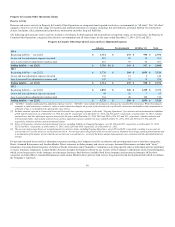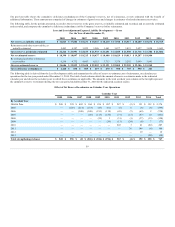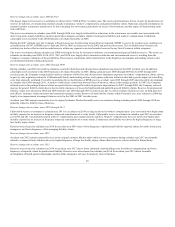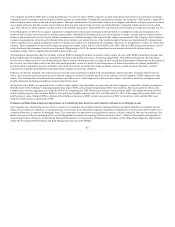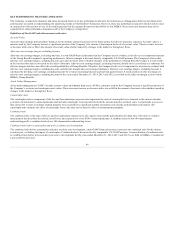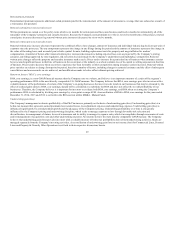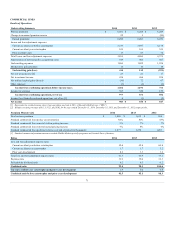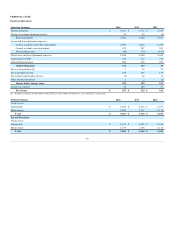The Hartford 2014 Annual Report Download - page 64
Download and view the complete annual report
Please find page 64 of the 2014 The Hartford annual report below. You can navigate through the pages in the report by either clicking on the pages listed below, or by using the keyword search tool below to find specific information within the annual report.
Valuation of Investments and Derivative Instruments
Fixed Maturities, AFS; Equity Securities, AFS; Equity Securities, FVO, Fixed Maturities, FVO; Equity Securities, Trading; and Short-term Investments
The fair value of AFS securities, fixed maturities, FVO, equity securities, trading, and short-term investments in an active and orderly market (i.e., not
distressed or forced liquidation) are determined by management after considering one of three primary sources of information: third-party pricing services,
independent broker quotations or pricing matrices. Security pricing is applied using a “waterfall” approach whereby publicly available prices are first sought
from third-party pricing services, any remaining unpriced securities are submitted to independent brokers for prices, or lastly, securities are priced using a
pricing matrix. Typical inputs used by these pricing methods include, but are not limited to, reported trades, benchmark yields, issuer spreads, bids, offers,
and/or estimated cash flows, prepayment speeds and default rates. Based on the typical trading volumes and the lack of quoted market prices for fixed
maturities, third-party pricing services will normally derive the security prices through recent reported trades for identical or similar securities making
adjustments through the reporting date based upon available market observable information as outlined above. If there are no recent reported trades, the third
party pricing services and brokers may use matrix or model processes to develop a security price where future cash flow expectations are developed based
upon collateral performance and discounted at an estimated market rate. Included in the pricing of asset-backed-securities ("ABS") and residential mortgage-
backed securities ("RMBS") are estimates of the rate of future prepayments of principal over the remaining life of the securities. Such estimates are derived
based upon the characteristics of the underlying structure and prepayment speeds previously experienced at the interest rate levels projected for the
underlying collateral. Actual prepayment experience may vary from these estimates. For further discussion, see the AFS Securities, Equity Securities, FVO
Fixed Maturities, FVO, Equity Securities, Trading, and Short-Term Investments section in Note 5 of Notes to Consolidated Financial Statements.
The Company has analyzed the third-party pricing services' valuation methodologies and related inputs, and has also evaluated the various types of
securities in its investment portfolio to determine an appropriate fair value hierarchy level based upon trading activity and the observability of market inputs.
For further discussion of fair value measurement, see Note 5 of Notes to Consolidated Financial Statements.
Derivative Instruments, including embedded derivatives within investments
The fair value of derivative instruments is determined using pricing valuation models for over-the-counter ("OTC") derivatives that utilize market data inputs,
quoted market prices for exchanged-traded derivatives and transactions cleared through central clearing houses ("OTC-cleared"), or independent broker
quotations. Excluding embedded and reinsurance related derivatives, as of December 31, 2014 and 2013, 96% and 97%, respectively, of derivatives, based
upon notional values, were priced by valuation models or quoted market prices. The remaining derivatives were priced by broker quotations. The derivatives
are valued using mid-market level inputs that are predominantly observable in the market with the exception of the customized swap contracts that hedge
GMWB liabilities. Inputs used to value derivatives include, but are not limited to, swap interest rates, foreign currency forward and spot rates, credit spreads
and correlations, interest and equity volatility and equity index levels. For further discussion on derivative instrument valuation methodologies, see the
Derivative Instruments, including embedded derivatives within the investments section in Note 5 of Notes to Consolidated Financial Statements. For further
discussion on GMWB and other guaranteed living benefits valuation methodologies, see the Living Benefits Required to be Fair Valued section in Note 5 of
Notes to Consolidated Financial Statements.
Limited partnerships and other alternative investments
Limited partnerships and other alternative investments include hedge funds where investment company accounting has been applied to a wholly-owned fund
of funds measured at fair value. These funds are fair valued using the net asset value per share or equivalent (“NAV”), as a practical expedient, calculated on a
monthly basis and is the amount at which a unit or shareholder may redeem their investment, if redemption is allowed. Certain impediments to redemption
include, but are not limited to the following: 1) redemption notice periods vary and may be as long as 90 days, 2) redemption may be restricted (e.g. only be
allowed on a quarter-end), 3) a holding period referred to as a lock-up may be imposed whereby an investor must hold their investment for a specified period
of time before they can make a notice for redemption, 4) gating provisions may limit all redemptions in a given period to a percentage of the entities' equity
interests, or may only allow an investor to redeem a portion of their investment at one time and 5) early redemption penalties may be imposed that are
expressed as a percentage of the amount redeemed. The Company assesses impediments to redemption and current market conditions that will restrict the
redemption at the end of the notice period. For further discussion of fair value measurement, see Note 5 of Notes to Consolidated Financial Statements. In
addition, certain limited partnerships and other alternative investments are accounted for under the equity method of accounting. For further discussion, see
the Investments - Overview section of Note 1 of Notes to the Consolidated Financial Statements.
64


